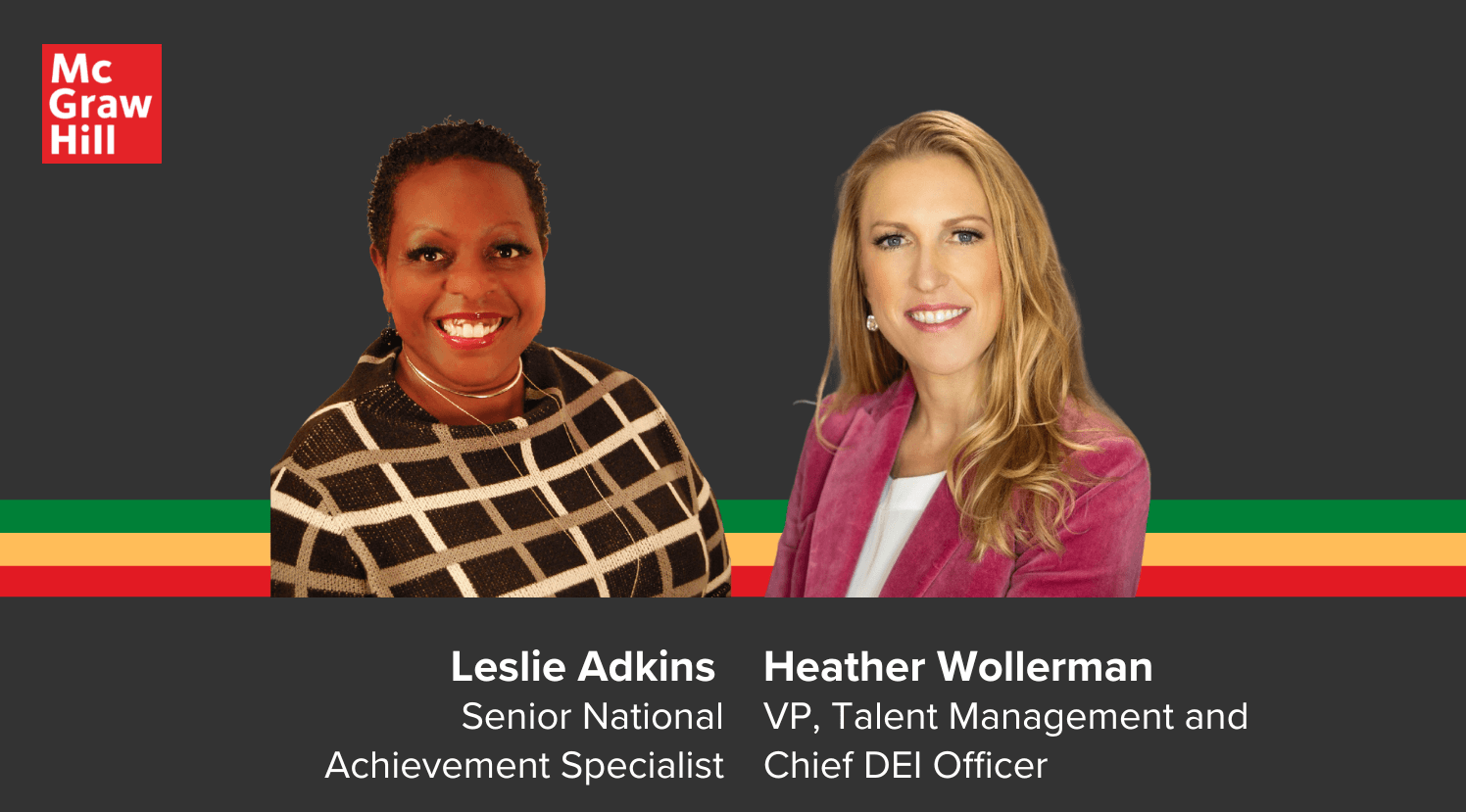My Account Details
‘My north star’: What allyship means at McGraw Hill
We recently sat down with Adkins and Wollerman to learn how allyship is being cultivated at McGraw Hill.

Last fall, Leslie Adkins and other members of BLACK @ MH, an employee resource group focused on providing professional development and advancement opportunities for Black employees at McGraw Hill, were considering the group’s 2023 priorities. Allyship topped the list. While the concept wasn’t brand-new to the company—the Women’s Leadership Initiative employee resource group, for example, had established a sponsorship program a few years ago—Adkins, a senior national achievement specialist, and her colleagues were eager to turn talk into action.
As it turns out, so was Heather Wollerman, who came on board in September as vice president, talent management and chief DEI (Diversity, Equity and Inclusion) officer. In addition to maximizing the company’s DEI efforts, she’s also been focused on raising awareness, ramping up educational opportunities and nurturing a culture where allyship could thrive.
We recently sat down with Adkins and Wollerman to learn how allyship is being cultivated at McGraw Hill, why allies need to take the initiative in educating themselves and how an inclusive culture ultimately benefits learners.
Allyship is a newer concept in many workplaces, including McGraw Hill, but one that’s crucial for inclusion and equity. How do you think about it, and what role can employee resource groups like BLACK @ MH play?
Heather Wollerman: Allyship in the workplace is where employees actively support underrepresented colleagues. It’s about understanding and empathizing in a way where the employees who don’t belong to a specific group can educate themselves and be advocates for their colleagues within the company.
Historically, we have a lot of participation in our employee resource groups (ERG), whether because employees feel underrepresented in the workplace or want a sense of community. There are also employees who aren’t members of an ERG based on their characteristics but want to support these groups and aren’t sure how. We encourage those employees to be part of the ERGs so they can understand, advocate for and help create a more inclusive workplace.
Providing education and awareness on what allyship means is part of our company-wide DEI strategy for this year and beyond. The ERGs want to bring in allies, to share with them what they can and grow and learn together.
Leslie Adkins: Initially, we didn’t have Black people coming to BLACK @ MH events. So we had to backtrack and do some things that were just Black focused to build the kind of community that could be receptive to allies. I’m excited to say we’ve done that work and will continue to do the work. Like Heather said, the ultimate goal is for everybody to learn and grow. As Black people at McGraw Hill, we needed to learn and grow with one another first before we could do that with the larger group. I think one of the things underrepresented groups sometimes struggle with is teaching the majority. But it’s not necessarily our job to always teach the majority.
Wollerman: To add to Leslie’s point, we as an ally community to our Black employees should take the initiative to read and learn, and then have psychologically safe conversations with our colleagues and ask questions. You can’t get spoon-fed all of it. You also have to be willing to learn yourself.
What does BLACK @ MH have planned for Black History Month, and what’s on tap the rest of the year?
Adkins: The theme of Black History Month this year is “Black Resistance,” and we’re doing a book study about Black joy as it focuses on resiliency, perseverance and resistance. When we're talking about Black joy with Black people, we're focused on the things that are dear to our hearts as well as on resources within McGraw Hill that are focused just on our specific group. The mindfulness app Headspace is one of them; it has a whole section dedicated to Black people.
Black mental health is a focus for us this whole year. We’re being creative in how we talk about resistance, focusing on things like Black trauma in the workplace. We’re also discussing how kids deal with trauma, which will give us greater insight into building a curriculum that meets the needs of all students.
We’re in the early stages of creating a mentorship program that pairs newer employees with people who have been here three years or more. It’s not about getting a promotion—just how to move within the company as someone who is underrepresented.
Even though we’re an ERG, we also want to work with Heather and her team as allies to make sure we have channels available to have more representation, particularly in senior leadership. We want to grow the incredible talent we have within the organization.
Wollerman: It’s exciting work, and it furthers the work we’re doing, including identifying top talent and making sure there’s a pipeline for them when we have key opportunities, especially in leadership roles.
How do you think all this work around DEI, particularly allyship, impacts the learners we serve?
Wollerman: Our journey in making ourselves better allies at McGraw Hill helps us support others on their journeys. Our ally communities that are creating products for schools are more aware, more inclusive, and that’s going to benefit everyone.
Adkins: I agree. We’re working to make diversity, equity and inclusion part of our DNA. Understanding our students is the end game. It’s about the products we put out and saying to our customers that everybody is important and has a voice. Making sure we get that done, making sure that everyone gets seen, is my north star.
Related Links:
Our employees, our pride
What employees are saying about working at McGraw Hill